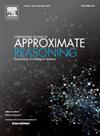选择符合保测度算法的星形集值数据中心
IF 3
3区 计算机科学
Q2 COMPUTER SCIENCE, ARTIFICIAL INTELLIGENCE
引用次数: 0
摘要
集值数据传统上是用通常的闵可夫斯基加法来表示Rd的非空紧集和凸子集。另一种可选择的、灵活的、允许功能表现的设置是星形设置。一个基于中心-径向特征的框架已经被引入,从统计的角度来处理这些集合。该算法是定向定义的,这对于表示高维中的不精确传播更自然。然而,确定星形集的中心的问题,既符合算术,又符合统计目的,还没有得到充分的解决。通过考虑一种保测度算法和一种完全兼容的中心选择算法,对星形集的方向特性进行了进一步的研究。新框架的实用性将用集值统计中的经典数据集来说明。本文章由计算机程序翻译,如有差异,请以英文原文为准。
Choosing the center of star-shaped set-valued data compatible with measure-preserving arithmetic
Set-valued data has traditionally been represented by considering non-empty compact and convex subsets of with the usual Minkowski addition. An alternative and flexible setting that admits a functional representation are the star-shaped sets. A framework based on a center-radial characterization has been introduced to treat these sets from a statistical point of view. The arithmetic is defined directionally, which is more natural for representing imprecision propagation in higher dimensions. Nevertheless, the problem of determining a center for star-shaped sets coherent with the arithmetic and sound for statistical purposes has not been fully addressed yet. The aim is to advance on the directional characterization for star-shaped sets by considering a measure-preserving arithmetic together with a center selection fully compatible with this arithmetic. The practicability of the new framework will be illustrated using a classical dataset in set-valued statistics.
求助全文
通过发布文献求助,成功后即可免费获取论文全文。
去求助
来源期刊

International Journal of Approximate Reasoning
工程技术-计算机:人工智能
CiteScore
6.90
自引率
12.80%
发文量
170
审稿时长
67 days
期刊介绍:
The International Journal of Approximate Reasoning is intended to serve as a forum for the treatment of imprecision and uncertainty in Artificial and Computational Intelligence, covering both the foundations of uncertainty theories, and the design of intelligent systems for scientific and engineering applications. It publishes high-quality research papers describing theoretical developments or innovative applications, as well as review articles on topics of general interest.
Relevant topics include, but are not limited to, probabilistic reasoning and Bayesian networks, imprecise probabilities, random sets, belief functions (Dempster-Shafer theory), possibility theory, fuzzy sets, rough sets, decision theory, non-additive measures and integrals, qualitative reasoning about uncertainty, comparative probability orderings, game-theoretic probability, default reasoning, nonstandard logics, argumentation systems, inconsistency tolerant reasoning, elicitation techniques, philosophical foundations and psychological models of uncertain reasoning.
Domains of application for uncertain reasoning systems include risk analysis and assessment, information retrieval and database design, information fusion, machine learning, data and web mining, computer vision, image and signal processing, intelligent data analysis, statistics, multi-agent systems, etc.
 求助内容:
求助内容: 应助结果提醒方式:
应助结果提醒方式:


